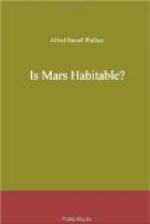Probable Function of the Great Fissures.
Mr. Pickering, as we have seen, supposes that these fissures give out the gases which, overflowing on each side, favour the growth of the supposed vegetation which renders the course of the canals visible, and this no doubt may have been the case during the remote periods when these cracks gave access to the heated portions of the surface layer. But it seems more probable that Mars has now cooled down to the almost uniform mean temperature it derives from solar heat, and that the fissures—now for the most part broad shallow valleys—serve merely as channels along which the liquids and heavy gases derived from the melting of the polar snows naturally flow, and, owing to their nearly level surfaces, overflow to a certain distance on each side of them.
Suggested Origin of the Blue Patches.
These heavy gases, mainly perhaps, as has been often suggested, carbon-dioxide, would, when in large quantity and of considerable depth, reflect a good deal of light, and, being almost inevitably dust-laden, might produce that blue tinge adjacent to the melting snow-caps which Mr. Lowell has erroneously assumed to be itself a proof of the presence of liquid water. Just as the blue of our sky is undoubtedly due to reflection from the ultra-minute dust particles in our higher atmosphere, similar particles brought down by the ‘snow’ from the higher Martian atmosphere might produce the blue tinge in the great volumes of heavy gas produced by its evaporation or liquefaction.
It may be noted that Mr. Lowell objects to the carbon-dioxide theory of the formation of the snow-caps, that this gas at low pressures does not liquefy, but passes at once from the solid to the gaseous state, and that only water remains liquid sufficiently long to produce the blue colour’ which plays so large a part in his argument for the mild climate essential for an inhabited planet. But this argument, as I have already shown, is valueless. For only very deep water can possibly show a blue colour by reflected light, while a dust-laden atmosphere—especially with a layer of very dense gas at the bottom of it, as would be the case with the newly evaporated carbon-dioxide from the diminishing snow-cap —would provide the very conditions likely to produce this blue tinge of colour.
It may be considered a support to this view that carbonic-acid gas becomes liquid at—140 deg. F. and solid at—162 deg. F., temperatures far higher than we should expect to prevail in the polar and north temperate regions of Mars during a considerable part of the year, but such as might be reached there during the summer solstice when the `snows’ so rapidly disappear, to be re-formed a few months later.
The Double Canals.
The curious phenomena of the ‘double canals’ are undoubtedly the most difficult to explain satisfactorily on any theory that has yet been suggested. They vary in distance apart from about 100 to 400 miles. In many cases they appear perfectly parallel, and Mr. Lowell gives us the impression that they are almost always so. But his maps show, in some cases, decided differences of width at the two extremities, indicating considerable want of parallelism. A few of the curved canals are also double.




